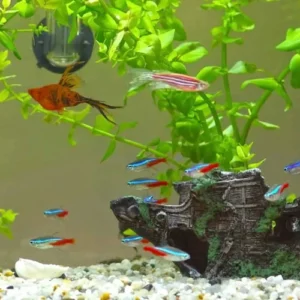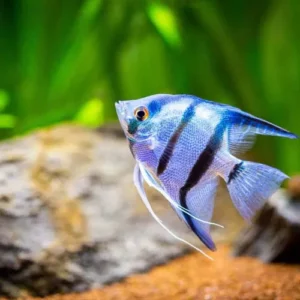Angelfish Care Guide: Mates, Tank Setup, Diet & Breeding
The Angelfish, known for their majestic beauty, are captivating creatures that make a stunning addition to any aquarium. Understanding these fish is crucial for providing them with the care they need. Angelfish, scientifically classified as Pterophyllum, belong to the Cichlidae family. Our Angelfish care guide will give you everything you need to know.
Home » Guides » Fish Care » Angelfish » Angelfish Care Guide: Mates, Tank Setup, Diet & Breeding
|
|
|
|
|
|
|
|
|
Angelfish Care Fact Sheet
| Scientific Name | Pterophyllum |
| Common Name | Angelfish |
| Care Difficulty | Easy |
| Minimum Tank Size | 20 Gallons (90 Liters) |
| Life Expectancy | 10 Years |
| Average Size | 6 Inch (15cm) |
| Temperature | 73-84°F (22-29°C) |
| Diet | Omnivore |
| Behavior | Friendly/Peaceful |
| Breeding | Easy/Medium |
| pH | 6-7 |
| dGH | 1-10 (0-180PPM) |
| Live Plant Friendly | Yes |
Introduction
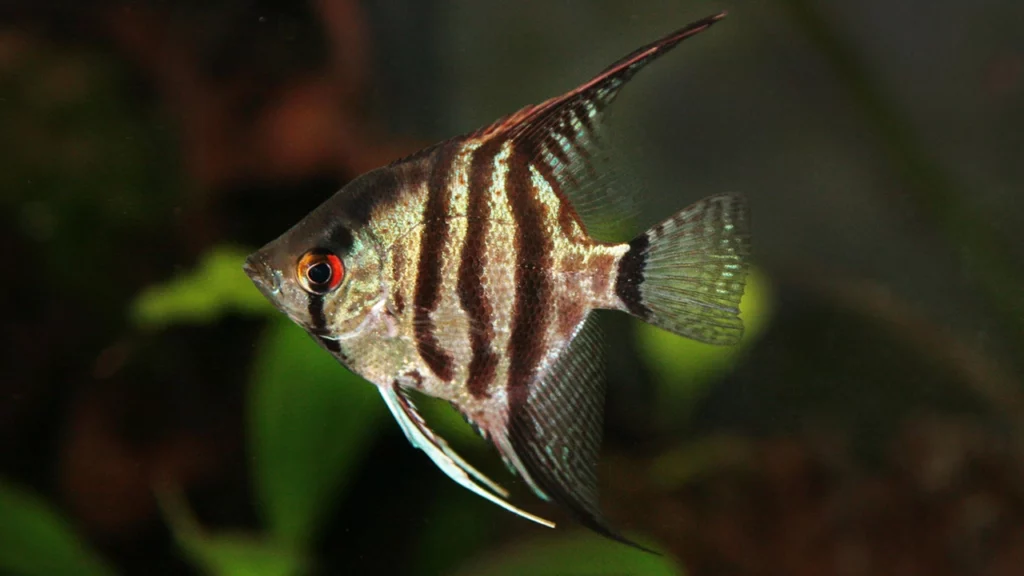
Natural Habitat and Origin of Angelfish
To truly appreciate the mystique of the angelfish, it’s essential to journey to the very heart of their origin – the sprawling waterways of South America. Imagine dense rainforests with rivers winding like serpents, the sun shimmering through dense canopies, and an orchestra of nature playing in the background. It’s here, in the calm, slow-moving tributaries, backwaters, and floodplains of the Amazon River basin, that the angelfish calls home.
The Amazon isn’t just any river; it’s a life force. Stretching over 7,062 kilometers, it’s one of the world’s longest rivers and is responsible for about one-fifth of the world’s freshwater flow. Such vastness provides a diverse array of habitats, perfect for species like the angelfish to evolve and flourish.
In the wild, angelfish are found in areas with dense aquatic vegetation. This not only provides them with necessary cover from potential predators but also offers a rich hunting ground for their insectivorous diet. It’s not uncommon to spot angelfish darting in and out of submerged roots, peering out from behind large leaves, or gliding gracefully amongst tall aquatic grasses. The water in these natural habitats is slightly acidic, soft, and often tinted a tea-color due to the decomposition of organic matter, like fallen leaves.
These natural habitats play a significant role in influencing the behavior and preferences of angelfish in home aquariums. The muted light that filters through the dense canopy in the wild, for example, is why angelfish often prefer subdued lighting in captivity. Their love for vegetation in the wild translates to a fondness for well-planted tanks.
Physical Characteristics And Lifespan of Angelfish
Angelfish are recognized for their distinctive triangular shape and long, flowing fins that resemble angel wings, hence their name. They exhibit vibrant colors and patterns, with variations including silver, black, white, and a multitude of other shades. Additionally, they possess a unique scallop-like pattern on their bodies, enhancing their visual appeal.
One remarkable characteristic of Angelfish is their size. These fish can grow up to 6 inches in height and can span their fins to a width of 8 inches. Their large size and graceful movement give them a regal and majestic presence in the aquarium. It is essential to consider their size and swimming needs when selecting an appropriate tank for them.
In terms of lifespan, Angelfish can live up to 10 years when provided with proper care and a suitable environment. This highlights the significance of creating an optimal habitat for them to thrive. With a lifespan of this magnitude, Angelfish have the potential to become long-term companions, rewarding their owners with their captivating beauty and graceful movements.
Setting Up Your Angelfish Aquarium
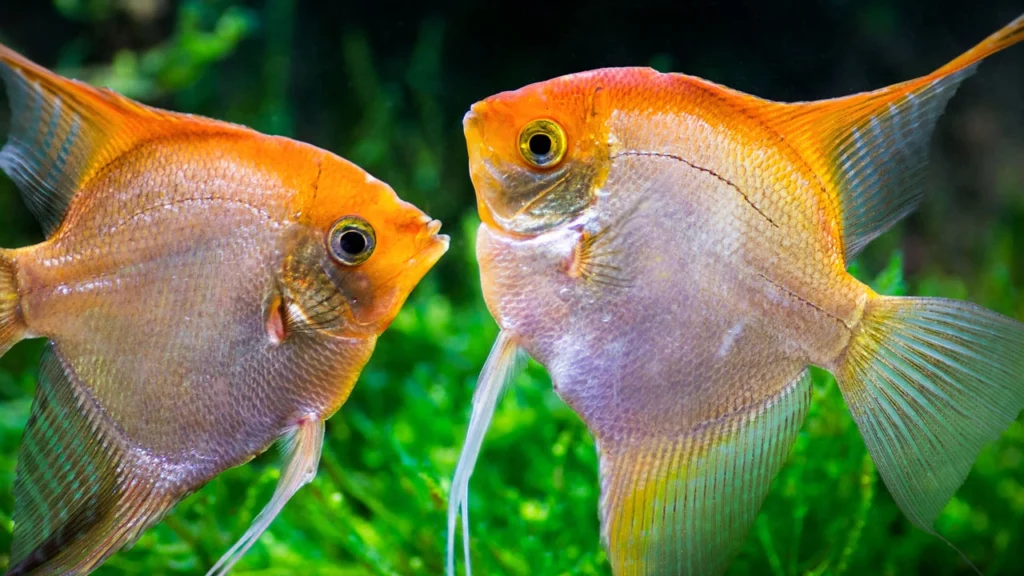
Choosing the Perfect Tank for Angelfish
One of the first things that budding aquarists quickly realize is that space matters – and this isn’t just about the physical space a tank occupies in your living room. It’s about the watery world you’re creating for your finned friends. For majestic creatures like angelfish, getting the tank size right is crucial, not just for their comfort, but for their overall well-being.
Now, angelfish, with their graceful long fins and poised demeanor, may appear delicate, but they can grow to a respectable size. A fully mature angelfish can reach a length of up to 6 inches, with a height (including those splendid dorsal and ventral fins) of up to 8 inches. Quite the stunner, right? But with such size comes the need for space to roam, turn, and express natural behaviors without hindrance.
For a pair of angelfish, a 20-gallon tank is the absolute minimum. However, I’m a firm believer in “the more, the merrier” philosophy when it comes to aquarium space. A 55-gallon tank is ideal for keeping a small group of these beauties, allowing them ample room to navigate and establishing territories without bumping into each other or the tank’s walls too often. If you’re planning on a community tank with other species alongside your angelfish, even more space will be beneficial.
But remember, it’s not just about the length and width; height is equally vital. Given the angelfish’s tall body shape, a taller tank ensures they can swim vertically without any constraints. This vertical space is especially crucial when they mature and their long fins fully develop.
Ideal Tank Conditions: Temperature, Hardness, and pH
Water, in all its flowing beauty, isn’t just a medium for our angelfish to swim in; it’s the essence of their very being. The quality and parameters of the water can be the difference between a thriving angelfish and one that’s merely surviving. As custodians of their little aquatic universe, it’s our duty to ensure this environment is as close to their natural habitat as possible.
pH Level: Angelfish naturally come from slightly acidic waters. Ideally, the pH for an angelfish tank should range between 6.0 to 7.5. However, they are adaptable and can tolerate slight variations, but sudden changes can be stressful. Always ensure any changes to pH levels are done gradually.
Hardness: Soft to moderately hard water is preferred. A dGH (degree of general hardness) between 3-8 is ideal. If your tap water is naturally harder, consider using driftwood or peat moss to naturally soften the water.
Ammonia, Nitrite, and Nitrate: These are the three parameters every aquarist should be familiar with. Ammonia and nitrite levels should always be zero in a well-cycled tank. Angelfish are sensitive to high nitrate levels, so aim to keep nitrates below 20 ppm. Regular water changes and a well-maintained filtration system can assist in maintaining these parameters.
Temperature: Just like you’d feel uneasy in a room that’s too hot or cold, angelfish thrive at specific temperatures. Being tropical fish, they prefer warmer waters. Aim for a temperature range between 76°F to 82°F (24°C to 28°C). An adjustable heater and a reliable thermometer are essential tools to ensure the water remains in this range.
TDS (Total Dissolved Solids): While not a parameter everyone checks, it’s worth mentioning. A TDS meter measures all organic and inorganic substances in the water. For angelfish, a range between 50-150 ppm is acceptable, though they can adapt to slightly higher values.
Suitable Plants and Substrate for Angelfish
Setting up an aquarium is akin to painting a landscape or sculpting a masterpiece. Every element, from the substrate to the decorations, plays a role in the overall aesthetics and functionality of the tank, especially when your aquatic muse is the elegant angelfish.
Substrate: Soft substrates are your best bet when considering angelfish. Fine sand or small, rounded gravel works well. Not only do they replicate the soft riverbeds of the Amazon, but they also reduce the risk of your angelfish injuring their delicate fins. Additionally, these substrates are great for live plants, which angelfish adore.
Plants: Speaking of plants, angelfish hail from densely vegetated waters, and thus, a well-planted tank will make them feel right at home. Consider plants like Amazon swords, which not only bear a geographical relevance but also provide broad leaves for angelfish to hide behind. Anubias, java fern, and valisneria are also excellent choices. These plants provide vertical coverage, allowing angelfish to glide between leaves, replicating their natural environment. Floating plants can be added to diffuse light and offer surface cover, making your fish feel more secure.
Decorations: While angelfish are the stars of the show, a few strategically placed decorations can accentuate their beauty. Driftwood, reminiscent of the submerged roots in their natural habitat, offers both aesthetic and functional benefits. They can serve as hiding spots, territorial markers, and even as a medium for beneficial bacteria. Smooth rocks or caves can be added, but ensure they don’t have sharp edges that might harm the fish.
Space: While it’s tempting to add numerous decorations, it’s vital to strike a balance. Angelfish need open spaces to swim freely. Overcrowding the tank with too many decorations can restrict their movement and lead to stress.
Colors: Opt for natural, muted tones when choosing substrates and decorations. These colors will not only highlight the angelfish’s vibrant patterns but also make them feel at ease, as it mirrors their natural surroundings.
Lights Control for Angelfish Care
Every time I reminisce about the vast rainforests of the Amazon, I’m reminded of the soft, dappled sunlight that filters through the dense canopy, casting a gentle glow on the water below. It’s this nuanced play of light and shadow that our angelfish have evolved in, and capturing this essence is vital for their well-being in captivity.
Lighting: Angelfish aren’t fans of glaring, bright lights. Remember, in their natural habitat, the light is often diffused by vegetation. A moderate lighting setup is ideal. LED lights with adjustable settings offer the best flexibility. You can control the brightness to achieve that gentle glow reminiscent of their wild surroundings. It’s also worth noting that many live plants favored by angelfish keepers thrive under moderate lighting, so it’s a win-win.
Having a consistent light cycle is crucial. Typically, 8 to 12 hours of light followed by 12 to 16 hours of darkness strikes a good balance. Employing a timer can ensure consistency, which is beneficial for both the fish and the plants.
Temperature: Temperature consistency is just as vital as the lighting. The warm waters of the Amazon basin have molded the angelfish’s preferences. A steady temperature between 76°F to 82°F (24°C to 28°C) is ideal. Fluctuations can lead to stress, making them susceptible to diseases. A high-quality heater with a thermostat can maintain the desired temperature range. Always have a separate thermometer to cross-check the water temperature and ensure the heater’s accuracy.
Shading: If you feel that your lighting might be too intense, consider natural ways to diffuse it. Floating plants like duckweed or water lettuce can offer dappled shading, mimicking the conditions angelfish are used to. These plants not only reduce light intensity but also offer a top layer refuge for angelfish, making them feel secure.
Selecting the Right Filtration System
There are three main types of filtration: mechanical, biological, and chemical. Mechanical filtration involves the physical removal of debris and particles from the water. This is typically achieved through the use of filter media, such as sponges or filter floss, which trap and remove solid waste. Regular cleaning or replacement of the mechanical media is necessary to prevent clogging and maintain efficient filtration.
Biological filtration is the process of cultivating beneficial bacteria that break down harmful substances, such as ammonia and nitrite, into less toxic nitrate. This is essential for maintaining a stable nitrogen cycle in the aquarium. The biological filtration is primarily provided by the filter’s biological media, such as ceramic rings or bio-balls, which offer a large surface area for the bacteria to colonize. Avoid excessive cleaning of the biological media to preserve the beneficial bacteria population.
Chemical filtration involves the use of specialized media, such as activated carbon or chemical resins, to remove dissolved impurities and contaminants from the water. This type of filtration is particularly useful for removing chemicals, odors, and discoloration. However, it is important to note that chemical filtration may also remove beneficial substances, so it should be used selectively and periodically.
Angelfish Care and Feeding
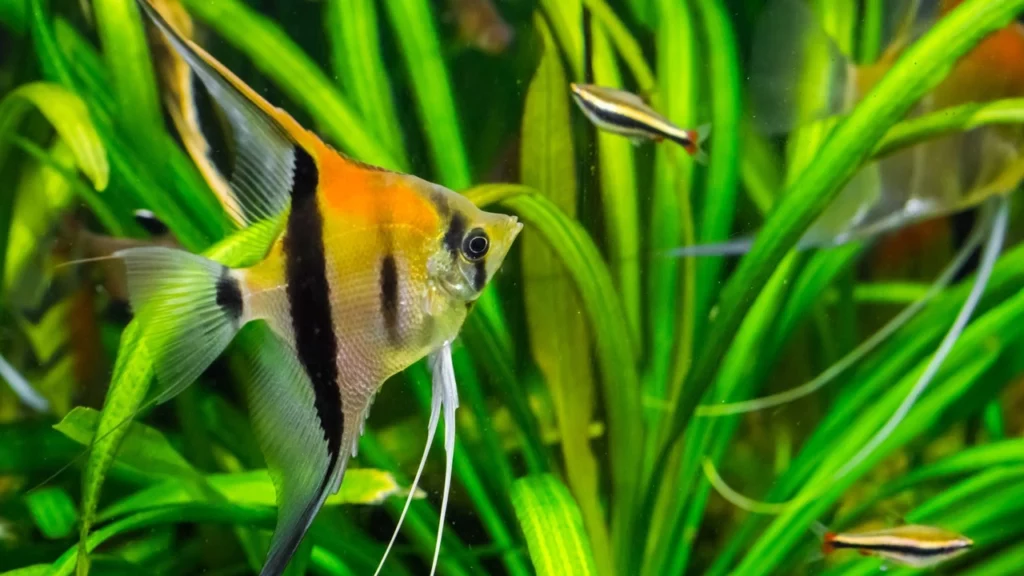
Ideal Diet for Angelfish
There’s a quaint saying that goes, “You are what you eat.” And in the world of angelfish, this rings exceptionally true. The radiant colors, the energetic sways, and the overall well-being of these regal beings are heavily influenced by their diet. Just as we revel in the joy of a hearty meal, angelfish too have their culinary preferences which, when catered to, ensures they are at their vibrant best.
Natural Diet: In the sprawling rivers of the Amazon, angelfish are opportunistic omnivores. They consume a varied diet comprising small crustaceans, insects, larvae, and plant matter. This diversity in their natural diet hints at the range of nutrients they require for optimal health.
Prepared Foods: In the confines of an aquarium, angelfish readily accept high-quality flakes and pellets formulated for tropical fish. These commercial foods are crafted to be nutritionally balanced, providing the essential proteins, fats, vitamins, and minerals. However, just as we wouldn’t enjoy eating the same meal every day, variety is the spice of life for angelfish too.
Live and Frozen Foods: To mimic their natural diet and offer a rich protein source, consider supplementing their diet with live or frozen foods. Brine shrimp, bloodworms, daphnia, and tubifex worms are some favorites. These not only provide essential nutrients but also stimulate their natural hunting instincts, keeping them active and engaged.
Vegetable Matter: Don’t forget the green side of their diet! Blanched vegetables such as spinach, lettuce, and zucchini can be introduced. Spirulina-based flakes or pellets are also an excellent addition, providing the necessary plant-based nutrients.
Angelfish Feeding Routine
We’ve all experienced that gentle nudge of routine in our lives. Whether it’s our morning coffee ritual or our evening walks, there’s a comforting predictability in knowing what comes next. For our angelfish, a feeding schedule offers similar predictability, ensuring their nutritional needs are met while avoiding the pitfalls of erratic feeding.
Consistency is Key: Fish, including our charismatic angelfish, have an innate sense of time, especially when it comes to food. By feeding them at consistent times daily, you help regulate their internal clocks, reducing stress and promoting healthy eating habits.
Twice a Day Rule: Generally, adult angelfish thrive when fed twice a day. This doesn’t mean doubling their food intake; instead, the daily quantity should be split into two servings. Morning and early evening are often ideal times, though the exact timing can be adjusted based on your schedule.
Juveniles Need More: Young, growing angelfish have a higher metabolic rate and, therefore, require more frequent feedings. Consider feeding them 3 to 4 times a day with smaller quantities to support their growth.
Vacation Plans: If you’re away for a day or two, adult angelfish can comfortably manage without food, drawing from their reserves. For extended absences, automatic fish feeders can be a godsend. These devices dispense pre-determined amounts of food at set intervals, ensuring your angelfish don’t miss a meal. Alternatively, you can also consider having a trusted person attend to the feeding.
Signs of Overfeeding and Underfeeding
As with all things in nature, balance is the key. This philosophy holds true when it comes to feeding our elegant angelfish. While their upturned mouths and graceful sways might often seem like an eternal plea for more food, it’s essential to recognize the signs when we’re serving too much or too little.
Overfeeding: The Unseen Consequences
- Water Quality Deterioration: Uneaten food settles at the bottom, decays, and releases ammonia – a harmful compound for fish. A spike in ammonia can lead to various health issues and even fatalities.
- Algae Bloom: Overfeeding indirectly contributes to the proliferation of algae. As leftover food decomposes, it releases nutrients beneficial for algae growth. A sudden algae outbreak can often be a red flag.
- Obesity: Yes, fish can get obese too! Overfed angelfish can develop a visibly rounder belly, which can lead to health issues and reduced lifespan.
- Digestive Issues: Feeding in excess can result in constipation in angelfish. You might notice them having difficulty swimming or producing stringy waste.
Underfeeding: The Subtle Signs
- Lethargy: A malnourished angelfish might not display its usual energy. Instead of swimming gracefully, it might stay in one spot or hide more frequently.
- Visible Thinness: The side profile of an underfed angelfish will show a concave belly, and its head might appear more prominent compared to its body.
- Nipping and Aggression: Hunger can make anyone grumpy! Angelfish might turn aggressive, nipping at tank mates or even showing signs of cannibalism in severe cases.
- Slow Growth: Especially in juveniles, insufficient nutrition can stunt growth, causing them to lag behind their counterparts.
Angelfish Behaviour
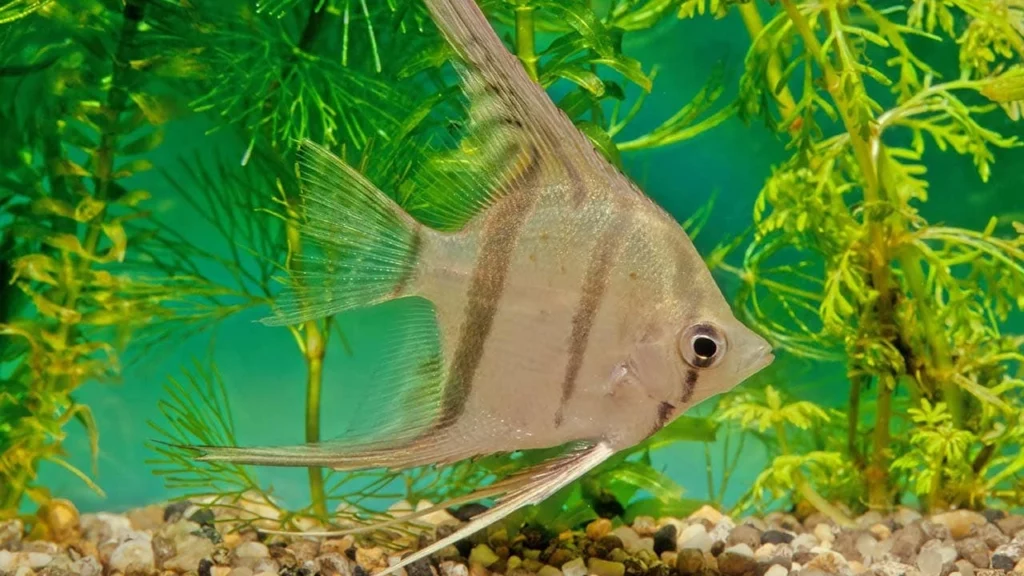
Temperament of Angelfish
There’s a mesmerizing ballet that takes place within the confines of an aquarium, and the angelfish are undeniably the principal dancers. Their long, flowing fins and elegant movements are a sight to behold. But, like all beings, they have a personality and temperament that’s crucial to understand, especially when considering their co-inhabitants.
Naturally Peaceful, But With a Caveat: Angelfish, by nature, are peaceful and prefer a serene environment. They coexist harmoniously with many other species in the vast Amazonian waters. However, they have their moments. When breeding or defending their territory, they can become more assertive, displaying a side that might surprise the uninitiated.
Size and Fins Matter: Angelfish are cichlids, and like their relatives, they can be territorial. They’re also quite sizeable compared to other common aquarium fish. This means tiny, fin-nipping species might not be the best companions, as the angelfish’s long, flowing fins can be too tempting a target.
The Vertical Space Lovers: Unlike many fish that traverse the breadth of the tank, angelfish tend to utilize the vertical space, gracefully gliding up and down. This behavior should influence both the tank’s design and the choice of tank mates. Fish that predominantly occupy the bottom, like some catfish species, can be excellent companions.
Breeding Aggression: The gentle ballet can momentarily turn into a passionate tango when it’s breeding time. Angelfish become fiercely protective of their eggs and fry. They might chase away or nip at other fish venturing too close to their breeding site. During such times, it’s essential to monitor the tank closely or consider temporarily isolating the breeding pair.
Angelfish Tank Mates
| I Get on With | I Sometimes Get on With | I Do Not Get on With |
|---|---|---|
| Angelfish | Discus | African Cichlids |
| Barbs | Eels | Betta Fish (Male) |
| Betta Fish (Female) | Giant Gourami | Fancy Goldfish |
| Bristlenose Catfish | Other Catfish | Frogs |
| Corydoras | South American Cichlids | Guppies |
| Crabs | Sharks | Knife Fish |
| Danio | Lobsters | |
| Dwarf Cichlids | Paradise Fish | |
| Eels | Rift Lake Cichlids | |
| Giant Gourami | Shrimp | |
| Gourami | Stingray | |
| L Number Plecos | ||
| Loaches | ||
| Minnows | ||
| Mollies | ||
| Paradise Fish | ||
| Platies | ||
| Rainbow Fish | ||
| Rasbora | ||
| Shrimp | ||
| Snails | ||
| Swordtails | ||
| Tetra |
Breeding Angelfish
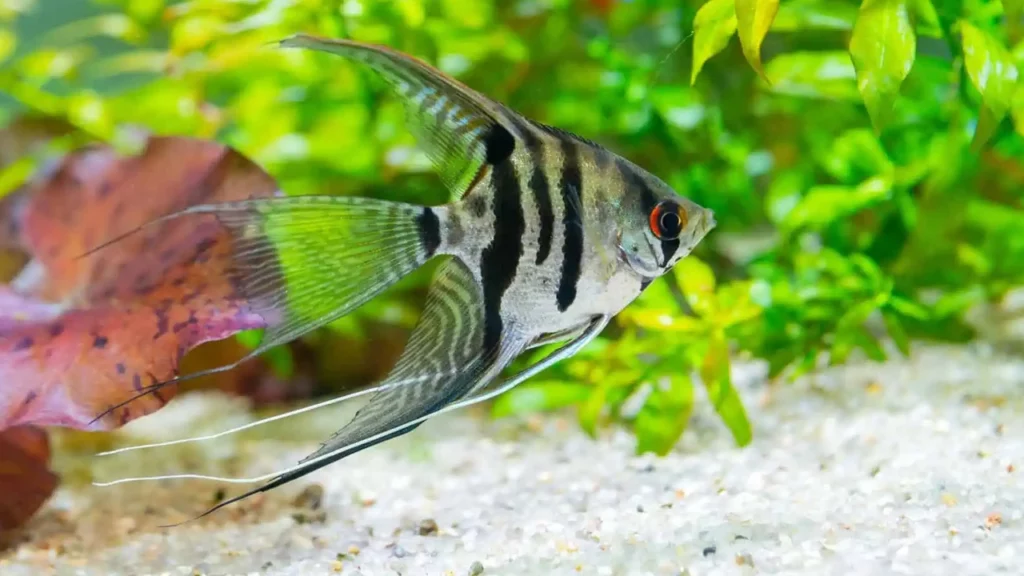
Angelfish Breeding Environment
When the time is ripe, and the stars (or rather, water parameters) align, angelfish embark on a beautiful journey of procreation. For aquarists, witnessing and facilitating this natural process is both a privilege and a testament to their fish-keeping expertise. But how does one set the stage for this aquatic romance? Let’s dive in.
Choosing the Right Pair: Nature has its mysterious ways, and not all angelfish will form breeding pairs. Observing your angelfish community will often reveal pairs forming naturally, recognized by their tendency to swim together and defend a shared territory. These self-chosen couples are often the most successful breeders.
Tank Specifications: While angelfish can breed in community tanks, a dedicated breeding tank offers better success rates. A 20 to 30-gallon tank often suffices, providing ample space for the pair and their offspring.
Substrate and Decor: Angelfish are known to lay eggs on broad-leaved plants, so introducing a few like the Amazon Sword Plant or artificial equivalents can offer them ideal spawning sites. A fine substrate, smooth rocks, or even slate tiles placed vertically can serve as alternative egg-laying surfaces.
Water Conditions: The quality of water plays a pivotal role in successful breeding. Soft, slightly acidic water (pH of 6.5 to 7.0) is ideal. Regular water changes, at least once a week, can simulate the rainy season conditions of their native habitat, which often triggers breeding.
Temperature Tuning: A slightly elevated temperature, around 80°F (27°C), can also act as a breeding inducer. However, ensure the rise is gradual and monitor the angelfish for any signs of discomfort.
Dietary Boost: Offering a varied, protein-rich diet in the weeks leading to breeding can enhance fertility. Live or frozen foods, like brine shrimp or bloodworms, serve as excellent supplements.
Privacy Matters: Just as we appreciate a bit of privacy in intimate moments, angelfish too prefer seclusion during breeding. If in a community tank, consider using tank dividers or plants to provide the breeding pair with their own private nook. In dedicated breeding tanks, minimal disturbance is key.
From Spawning to Fry
From the intricate courtship dances to the attentive care for their offspring, the journey of angelfish from spawning to fry is a lesson in nature’s delicate balance and beauty.
Courtship Rituals: As the breeding period approaches, you’ll observe the chosen pair spending more time together, dancing around each other in a mesmerizing display. This intricate dance is accompanied by gentle nips and nudges, signaling their readiness to spawn.
Choosing the Perfect Spot: The female angelfish will scout for the perfect location to lay her eggs. Be it on a broad leaf, a slate, or even the aquarium glass, she seeks a spot that feels safe and conducive for her future offspring. The pair will often be seen cleaning the chosen site diligently, ensuring it’s free of any debris or algae.
Egg Laying: Once the spot is primed, the female begins the egg-laying process. She gracefully glides over the chosen surface, depositing a line of eggs, which the male promptly follows up by fertilizing. This dance continues until she’s laid all her eggs, which can number anywhere from a few hundred to even a thousand!
Guardians on Duty: Angelfish are exceptional parents. Once the eggs are laid, both parents take turns fanning them with their fins, ensuring a constant flow of oxygen. They’re also fiercely protective, warding off any potential threats to their precious cache.
The Hatching: In about 48-72 hours, if the conditions are right and the eggs are fertilized, tiny wriggling larvae emerge. These are not fully formed fish but are instead a stage called ‘wrigglers’. At this point, they are still attached to the egg surface and rely on their yolk sac for nutrition.
Caring for Angelfish Fry
With the right care and conditions, these tiny beings can grow into majestic, fully-fledged angelfish that become the pride of any aquarium. As with any young life, the early stages are crucial, demanding both attention and understanding.
1. First Foods:
In their initial days after becoming free-swimming, angelfish fry thrive on minute organisms called infusoria. Given their tiny size, fry need food that they can easily ingest. As they grow, baby brine shrimp becomes an ideal choice, providing both nutrition and the right size for consumption. Liquid fry food and specially formulated fry powder are also excellent options available in the market.
2. Frequent Feedings:
Young fry have voracious appetites, necessitating multiple feedings throughout the day. Typically, 3 to 5 times a day should suffice. But remember, small portions are the key to prevent overfeeding and maintain water quality.
3. Clean, Safe Waters:
Fry are particularly sensitive to water conditions. Regular water changes (daily or every other day) are essential. However, ensure the new water matches the tank’s temperature to avoid shocking the fry. A gentle air-powered sponge filter can keep the water clean without posing a threat to the delicate fry.
4. Provide Shelter:
Adding fine-leaved plants or mosses gives fry natural hiding places, making them feel secure. Java moss, for instance, not only offers shelter but can also be a source of infusoria for the fry.
Common Angelfish Diseases And Treatments
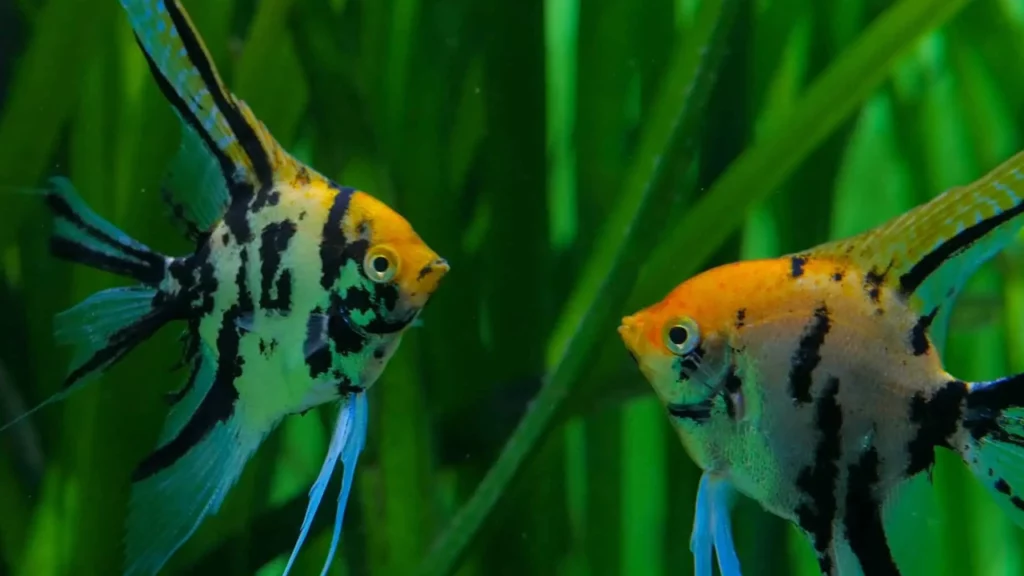
Ich (White Spot Disease)
Ich, also known as White Spot Disease, is a common parasitic infection that can affect Angelfish. Recognizing the symptoms and taking prompt action is crucial for effectively treating and preventing the spread of this disease.
Ich is caused by the parasite Ichthyophthirius multifiliis, which attaches to the fish’s skin and causes the formation of small white spots resembling grains of salt or sugar. These spots may be visible on the fish’s body, fins, or gills. Infected Angelfish may display symptoms such as flashing (rubbing against objects), increased respiratory rate, loss of appetite, and behavioral changes.
To effectively deal with Ich, several treatment options are available and can be found here.
Fin Rot
Fin Rot is typically caused by the bacteria from the Aeromonas, Pseudomonas, or Flexibacter genera. It often occurs as a result of poor water quality, stress, or injuries that provide an entry point for the bacteria. Common symptoms of Fin Rot include frayed or ragged fins, discoloration, inflammation, and deterioration of the fin tissue. In severe cases, the infection can progress and affect other parts of the fish’s body.
Treating Fin Rot involves a combination of steps to eliminate the bacteria and promote healing. We explain more in our Treating Fin Rot Guide.
Velvet Disease
The velvet disease, scientifically known as Oodinium, is a common ailment affecting angelfish. It’s a parasitic skin disease caused by the dinoflagellate parasite, Oodinium pilularis. Initial symptoms of velvet can often be missed due to its subtle onset. The fish may display signs of lethargy and a loss of appetite.
The most distinctive symptom of velvet is a fine, dust-like, yellowish coating on the body of the fish. This can often give the angelfish a velvety appearance, hence the disease’s name. This coating is a cluster of parasites feasting on the angelfish’s skin and gills, which causes immense discomfort.
In advanced stages, the affected angelfish may show labored breathing due to the parasites’ infiltration of the gills. In such cases, immediate intervention is essential to prevent further complications. Increased fish mortality is observed when velvet disease is not treated promptly and correctly.
If you believe your Angelfish has Velvet Disease, read here on how to treat it.
Swim Bladder Disease
One of the main symptoms of Dropsy is the visible swelling or bloating of the fish’s body, giving it a pinecone-like appearance. Other signs include loss of appetite, lethargy, clamped fins, and the presence of scales sticking out or raised. Dropsy is typically caused by a bacterial infection that affects the fish’s internal organs, leading to fluid retention and the subsequent swelling.
Addressing Dropsy in Angelfish requires a multi-faceted approach that includes proper diagnosis, supportive care, and treatment. Due to it’s deadly nature, Dropsy can be hard to treat.
Frequently Asked Questions – FAQ
Give Us Feedback
Please help us get better by making suggestions or giving feedback, we really do listen to it!
